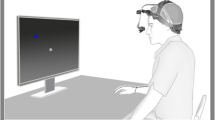Abstract
The presence of voluntary eyelid movement disorders was systematically checked in 51 patients with a recent stroke supposedly confined to one hemisphere and presenting with contralateral gaze impairment.
Inability to initiate lid closure was found in 5 patients, inability to keep the eyes closed for more than 1–3 sec in 5 patients and inability to initiate eyelid opening in 1 patient. One patient failed both to close his eyes and to open them when closed. In 3 patients the deficit was restricted to the eye contralateral to the lesion. CT scan findings pointed to the parietal lobe as the cortical area more frequently encroached upon by the lesion. In one patient brain damage was restricted to the right motor supplementary area and cingulate gyrus and produced, in addition to failure to close eyelids, inability to carry out any voluntary movement governed by cranial nerves save eye movements.
Sommario
La presenza di alterazioni dei movimenti volontari delle palpebre fu sistematicamente controllata in 51 pazienti affetti da un ictus di data recente interessante un solo emisfero e che presentavano deficit dello sguardo controlaterale alla lesione. L'incapacità di chiudere le palpebre fu osservata in 5 pazienti, quella di mantenere le palpebre chiuse per piu di 1– 3 secondi in 5 pazienti e quella di aprire le palpebre in 1 paziente. Un paziente era incapace sia di chiudere gli occhi che di aprirli una volta chiusi. In 3 pazienti il deficit era presente solo nell'occhio controlaterale alla lesione. I dati forniti dalla TAC indicarono che l'area corticale più frequentemente interessata era il lobo parietale. In unpaziente il danno cerebrale era limitato all'area motoria supplementare e al giro cingolato di destra e aveva prodotto l'incapacità non solo di chiudere gli occhi, ma anche di eseguire qualsiasi altro movimento controllato dai nervi cranici, eccetto i movimenti oculari.
Similar content being viewed by others
References
Alajouanine, Thurel, R. La diplégie faciale cerebrale. Forme corticale de la paralysie pseudobulbaire. Rev. Neurol. 2, 441–458, 1933.
Arrigo, A. Un caso di incapacità di chiusura volontaria delle palpebre. Studio clinico ed elettromiografico. Riv. Pat. Nerv. Ment. 83, 40–58, 1962.
Berlin, L. Compulsive eye opening and associated phenomena. Arch. Neurol. Psychiat. 73, 597–601, 1955.
Cartei, M. Un caso di aprassia della chiusura delle palpebre in soggetto affetto da sclerosi a placche: considerazioni clinico-patogenetiche. Riv. Neurol. 46, 57–72, 1976.
Damasio, A.R., Van Hoesen, G.W. Structure and function of the supplementary motor area. Neurology 30, 359, 1980.
Dehaene I., Bogaerts, M. La paralysie supranucléaire progressive. Acta Neurol. Belg. 71, 141–145, 1971.
Dehen, H., Cambier, J. Non fermeture volontaire des paupières, impersistance motrice et spécialization fonctionelle hémisphérique. Rev. Neurol. 135, 573–582, 1979.
Ferro, F.M., Anepeta, L., Maurillo, M. Considerazioni su due casi di “aprassia” della chiusura e dell'apertura degli occhi. Riv. Pat. Nerv. Ment. 90, 300–308, 1969.
Fisher, C.M. Left hemiplegia and motor impersistence. J. Nerv. Ment. Dis. 123, 201–218, 1956.
Goldstein, J. E., Cogan, D.G. Apraxia of lid opening. Arch. Ophtalm. 73, 155–159, 1965.
Joynt, R.J., Benton, A.L., Fogel, M.L. Behavioral and pathological correlates of motor impersistence. Neurology, 12, 876–881, 1962
Lapresle, J., Salisachs, P. Phénomènes de dissociation volontaire et automatico-réflexe au niveau de certains muscles innervés par les paires craniennes dans deux observations de sclérose latérale amyothrophique. Rev. Neurol. 132, 157–167, 1976.
Lessel, S. Supranuclear paralysis of voluntary lid closure, Arch. Opthalm. 88, 241–244, 1972
Lewandowsky, M. Ueber die Bewegungstörungen der infantilen Hemiplegie und über die Athetose double. Deutsch. Zeitscnr. f. Nervenheilk. 29, 339–368, 1905.
Lewandosky, M. Ueber Apraxie des Lidschluss. Berlin Klin. Wochenschr.44, 921–923, 1907
Monaco, F., Pirisi, A., Sechi, G.P., Cossu, G. Acquired ocular-motor apraxia and right-sided cortical angioma. Cortex 16, 159–167, 1980.
Nashold, B.S., Gills, J.P. Ocular signs from brain stimulation and lesion. Arch. Ophtalm. 77, 609–618, 1967.
Nutt, J.G.,Lid abnormalities secondary to cerebral hemisphere lesions. Ann. Neurol. 1, 149–151, 1977.
Pineas, H. Hirnbefunde bei Apraxie. Zentralbl. f. Ges. Neurol. Psychiat. 34, 446–448, 1924.
Rasmussen, Th., Penfield, W. Movement of head and eyes from stimulation of human frontal cortex. In: The Frontal Lobes, A.R.N.M.D. vol. XXVII, pp. 346–361, 1947.
Riese, W. Apraxie des Lidöffnung (Analyse eine Bewegungsstörung) J. Psychol. Neurol. Lpz. 40, 347–355, 1930.
Rosati, G., De Bastiani, P., Granieri, E., Agnetti V. Voluntary lid closing inability. Release of a compulsive reaction to the exploration of the environment. Arch. Psychiat. Nervenkr. 226, 11–17, 1978.
Ross Russel, R.W.R. Supranuclear palsy of eyelid closure. Brain 103, 71–82, 1980.
Roth, W.C.,Demonstration von Kranken mit Ophtalmoplegie. Neurol. Centralbl. 20, 921–923, 1901.
Schilder, P. Zur Pathologie des Lidschlusses. Dtsch. Z. Nervenheilk 90, 172–176, 1926.
Schilder, P. Neuer Beitrag zur Pathologie der Lidbewegungen. Dtsch Z. Nervenheilk, 98, 161–168, 1927.
Zutt, J. Ueber die Unfähigkeit die Augen geschlossen zu halten. Apraxie des Lidschlusses oder Zwangblicken? Nerve narzt 21, 339–345 1950.
Author information
Authors and Affiliations
Rights and permissions
About this article
Cite this article
Colombo, A., De Renzi, E. & Gibertoni, M. Eyelid movement disorders following unilateral hemispheric stroke. Ital J Neuro Sci 3, 25–30 (1982). https://doi.org/10.1007/BF02043344
Issue Date:
DOI: https://doi.org/10.1007/BF02043344




